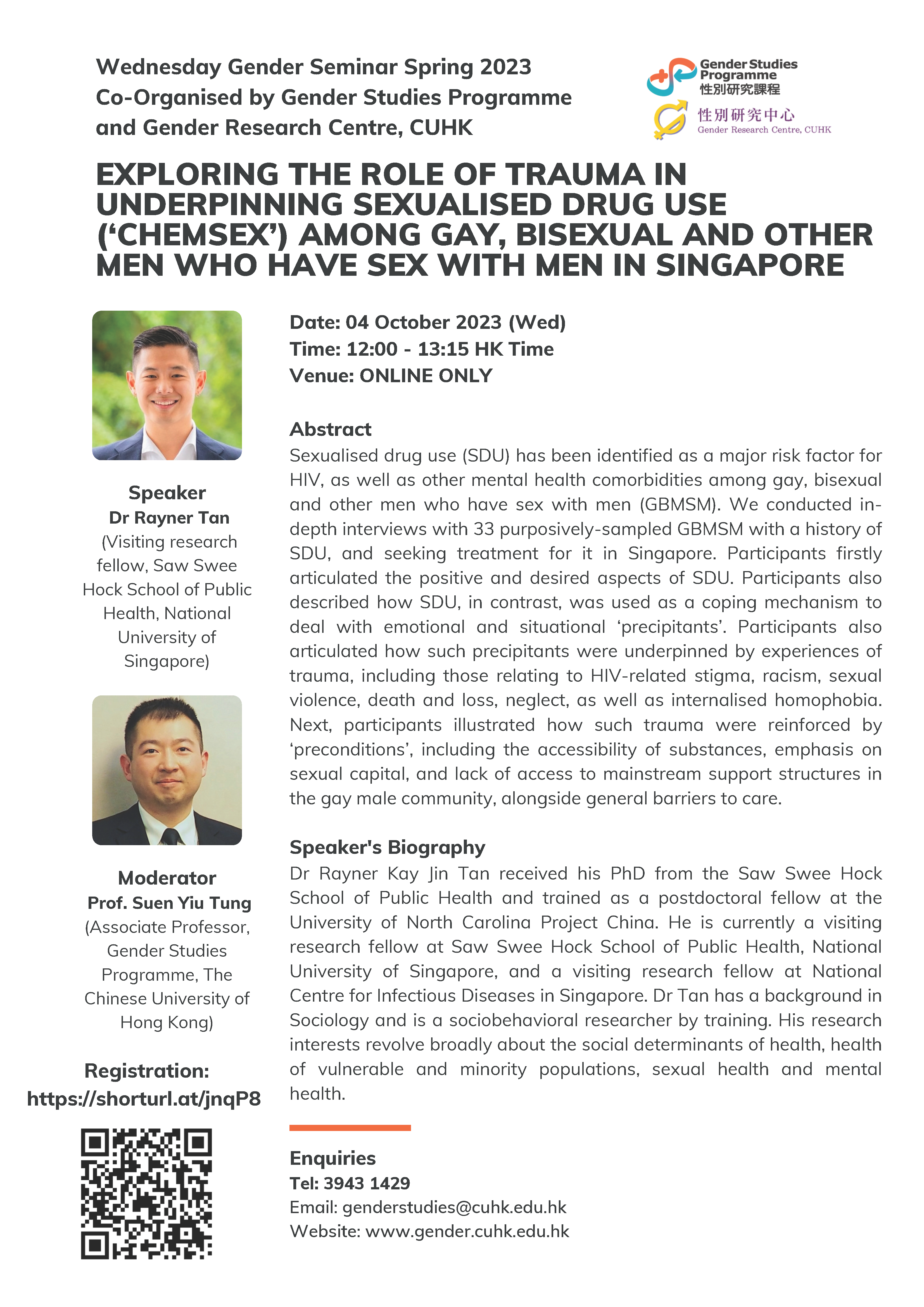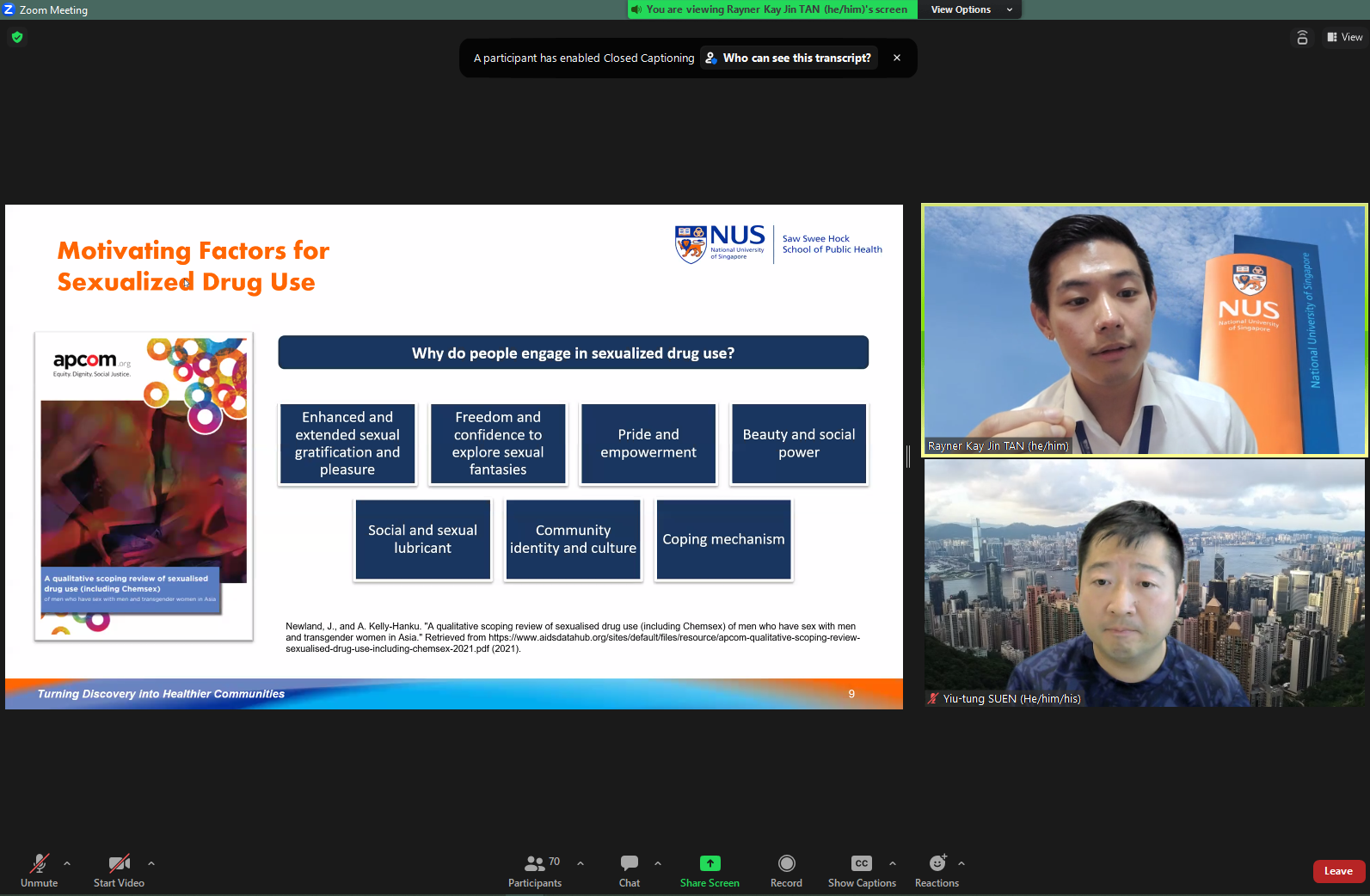“Chemsex”, related to but distinct from broader sexualized drug use, generally refers to use of psychoactive substances within sexual contexts. With growing research indicating its prevalence in gender and sexual minority populations and its associations with HIV, STIs and mental health comorbidities, it is considered to be an urgent public health and health equity issue. Primarily drawing from his recent qualitative study examining “chemsex” engagement amongst gay, bisexual and other men who have sex with men (GBMSM) in Singapore, Dr. Tan’s talk centered around the multidimensional antecedents underlying this phenomenon.
Under an interpretivist epistemological orientation, the qualitative study employed positionality/reflexivity-informed semi-structured interviews with a purposive sample of 33 self-identified GBMSM in Singapore followed by inductive thematic analysis. The interview process inquired into participants’ life histories and “chemsex”-related experiences, and participant welfare was ensured through methodological incorporation of anonymity protecting mechanisms coordinated by community-based organizations and the National University of Singapore. Interview results suggested several factors driving GBMSM’s chemsex engagement, including: 1) positive, desired aspects of “chemsex” (e.g., connectedness, sexual enhancement), 2) “chemsex” as a mechanism to cope with varied precipitants (e.g., sexual shame, low self-esteem), 3) traumatic underpinnings of such precipitants (e.g., intracommunity racism, societal-level homophobia), and 4) trauma-reinforcing preconditions of “chemsex” (e.g., sexual capital emphasis, lack of mainstream or institutional support structures). From such results, a trauma-informed, socio-ecological framework to conceptualize “chemsex” was proposed.
Dr. Tan’s talk ultimately provides novel, nuanced sociopolitical insights into “chemsex”, as well as challenges biomedical and pathologizing understandings of “chemsex” which characterize some extent of past literature and predominate popular discourse. Significant practical implications for community and healthcare settings may also be inferred, particularly the development of person-centered, multi-pronged harm prevention and reduction strategies to counter problematic forms of “chemsex”, especially in vulnerable minority populations.
撰文:LEUNG, Sinyu
Dr. Rayner TAN shared his recent work on what drives for underpinning sexualized drug use in the gay, bisexual and other men who have sex with men (GBMSM) community in Singapore, with a special focus on the role of trauma. Sexualized drug use, also termed as ‘chemsex’, generally refers to the use of psychoactive substances for sexual reasons. This study conducted semi-structured in-depth interviews with 33 GBMSM participants and used thematic analysis to analyze the interviews. The interview topics revolve on life history, trauma, HIV status, chemsex, barriers to accessing drug use recovery services, and incarceration.
As a result, a trauma-informed framework was conceptualized to describe the factors driven for sexualized drug use from psychological, societal, and structural levels. Firstly, for the positive and desired aspects of chemsex, participants stated that they experienced positive emotional states, sexual enhancement, love and intimacy. Secondly, participants explained their precipitants to chemsex. They regarded chemsex as a coping strategy to address individual and interpersonal stress (e.g., emotional wounds, loneliness, sexual shame, and social connections) and external stress related to work, finance, and family. Thirdly, participants pointed out the significant role of trauma in sexualized drug use, which came from HIV-related stigma, racism, homophobia, religious trauma, neglect, sexual violence, death and loss. Lastly, the societal and structural context resulted in preconditions that reinforced participants to engage in chemsex. The drug used for sex is easy to access, and the environment accepts chemsex as a norm. Besides, there is limited formal support for the GBMSM community such as LGBTQ friendly aftercare, family support, and legal support. On the other hand, participants also reported that the inadequate available help, stigma about drug use, and fear of being reported impeded their motivation seeking for caring support.
Overall, the research investigated sexualized drug use from the lens of coping strategies to trauma. It showed that the GBMSM community reinforced the experiences of sexualized drug use to cope with trauma and other societal factors but were also precluded from getting formal support due to those unfriendly preconditions. Even though chemsex may not cause problematic addiction and health issues to everyone, more inclusive interventions are needed for the GBMSM community to receive drug use treatment care and support.
撰文:LI, Ang
This lecture aims to explore the role of trauma in underpinning sexualised drug use (‘Chemsex’) among gay, bisexual and other men who have sex with men in Singapore. The speaker is divided into five parts to illustrate this topic: Introduction: Sexualized Substance Use or ‘Chemsex’, Preliminary Work on Sexualized Substance Use, ‘chasing utopias’: methods, Findings and Discussion.
First of all, in the introduction, the controversy caused by Chemsex as a public health issue was introduced. Then the speaker listed the related data of ‘Sexualized Drug Use in Key Populations’ and the motivation factors leading to this phenomenon. He then shifts his perspective to explore the underlying logic behind ‘The Rush To Risk’. What surprised me in this part is that the data and proportion of the use of sexualized drug exceeded my expectation, and the reasons behind it mentioned that the use of drugs does not necessarily have side effects, and drugs can also play a spiritual auxiliary effect in addition to physiological effects in sexual behavior.
Secondly, in the Preliminary Work, the speaker set Rationale and Objectives, and referred to previous works on Chemsex for research design and implementation. The survey covered Chemsex measures, Class differences, Social Capital and more.
Thirdly, the research method part states four aspects: Study Design & Participants, Date Generation, Topic Guide, Positionality & Reflexivity. The date generation mentioned the design principles and some details of the interview. First, in-depth interviews can be conducted on the basis of ensuring that the human rights of the interviewees are not infringed. Second, the interview can be conducted on the premise that the interviewer and interviewees do not know each other, so that the interview content can be as free from the influence of subjective consciousness as possible. In other words, if the two know each other, the interviewer will have preconceived ideas and affect the thinking and judgment of this research topic.
Next, the speaker summarized the key findings: First, positive and desired Chemsex can bring a sense of peace, sexual enhancement, love and intimacy. Second, precipitants, from the perspective of individual and interpersonal, have emotional wounds, loneliness, sexual shame and social connections; From the perspective of external factors, it is mainly caused by work-related stress, financial and family-related stress. Third, Different types of trauma caused by Intracommunity, general society and discrete incidents, namely HIV-related stigma and racism; homophobia, religious trauma, neglect; sexual violence, death and loss. Fourth, is four Preconditions: 1. Normative aspects: Ease of access, Chemsex as a norm; 2. Sexual capital: Sexual attractiveness as self-worth, Lack of safe spaces; 3. Lack of formal support: No LGBTQ-friendly aftercare, Lack of family support, Lack of legal support; 4. Barriers to care: Perceived lack of available help, Stigma around drug use, Fear of being reported.
Finally, there is the discussion section. the speaker believes that Data generated reflects just this slice of lived experiences and world views. At the same time, three aspects of Person-centred harm reduction interventions are proposed: 1. Sexualized drug use journey; 2. Engagement in sexualized drug use; 3. Personal Life Course.
撰文:LI, Yushan
The theme of the seminar this week is ‘exploring the role of trauma in underpinning sexualized drug use (‘chemsex’) among gay, bisexual and other men who have sex with men in Singapore’. First of all, Dr Tan shared the definition of sexualized drug use, which means the use of psychoactive substances for the purpose of having sex or in sexual contexts, and the key population of sexualized drug users are gay and transgender women. Then Dr Tan introduced the motivating factors of for sexualized drug use, including enhanced and extended sexual gratification and pleasure, freedom and confidence to explore sexual fantasies, pride and empowerment and so on. In order to best understand the risk of sexualized drug use, Dr Tan suggested us to acknowledge non-problematic use, simultaneously reframing the role of drugs in sexual behaviors and moving beyond biomedical forms of understanding, while he also introduced some research from different viewpoints and cite the relevant studies in Singapore, importantly including the modified socio-ecological framework of factors driving chemsex among GBMSM. Based on presentation upon, Dr Tan shared his study design and method, through purposive and theoretical saturation guided sampling 33 participants were recruited into the research and carried out on the basis of interpretivist epistemological orientation. The findings of this study mentioned four aspects: positive and desired chemsex (participants articulated desired and positive aspects of chemsex), precipitants (individual and interpersonal reasons including emotional wounds, loneliness, sexual shame etc.), trauma (in intracommunity, general society and discrete incidents), preconditions (normative aspects, sexual capital, lack of formal support, barrier to care etc.). After all, Dr Tan concluded the findings of the study, although the generated data only reflects slice of lived experiences and world views, the chemsex journey and its harm and reduction still make a sense to the various realms of homosexual research.
撰文:LI, Zhixin
On 4th Oct 2023, Wednesday Gender Seminar invited Dr Rayner Tan to share his research on the role of trauma in underpinning sexualised drug use (‘chemsex’) among gay, bisexual and other men who have sex with men (GBMSM) in Singapore.
Although “chemsex” as a public health issue has been widely studied in public health scholarship, there is a tendency to oversimply frame and label sexual drug use as pathological or risky, which conflates various problems and may further generate and reinforce stigmatization of sexual minorities. Dr Tan, thus, emphasized the need to acknowledge multiple motivations and move beyond biomedical forms of understanding. He shifted the research focus to the structural and social context of SDU to better understand causes and debunk problematic narratives. In his study, “trauma” was a strong and recurrent theme underpinning informants’ reports, which is understudied in the existing literature.
Dr Tan’s qualitative study adopted semi-structured in-depth interviews with 33 participants who were self-identified GNMSM and seeking treatment in Singapore. Interview topics included participants’ experiences and life histories of SDU, substance use, incarceration, trauma, and recovery stories. In reports, desired and positive aspects were articulated, such as peace, intimacy, and sexual enhancement. They took chemsex to cope with ‘precipitants’, a term referring to emotions and situations like negative individual and interpersonal issues and stressful external factors like family-related stress. Participants further pointed out how trauma experience provided context for ‘precipitants’ and underpinned them. Such trauma included three significant types: intracommunity, including HIV-related stigma and racism; general society, including internalization of homophobia and discrete incidents. Importantly, these traumas were related to 4 kinds of ‘preconditions’, including the accessibility of substances, sexual capital, lack of formal support and barriers to care, which also, in turn, motivate engagement in chemsex.
Grounded in sexualized drug users’ life stories, Dr Tan’s trauma framework offers a refreshing perspective to understand how social and structural factors produce and reinforce SDU and suggests the necessity to address individual trauma and structural problems when intervention.
撰文:LIU, Danchen





A
A
A
聯絡我們